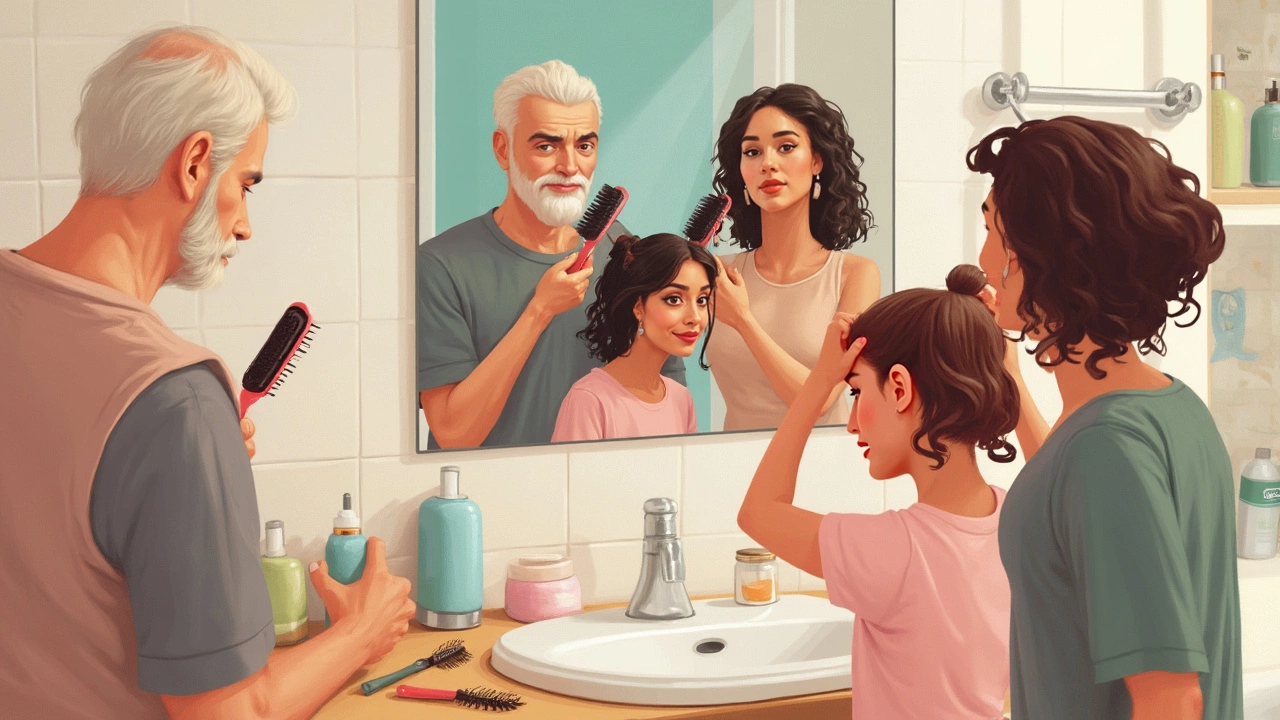
Ever felt like your hair just has a mind of its own? One moment it’s glorious, and the next, it’s a frazzled mess. Turns out, nature itself can be a sneaky culprit when it comes to hair damage. Whether it’s the harsh rays of the sun or the seemingly innocent fabrics we use every day, your hair faces many natural enemies.
Let's talk about sun exposure first. It might feel great to have the sun warming your scalp, but those UV rays are basically like a mini blow torch to your hair. They zap moisture right out, leaving your hair brittle and dry. Try wearing a hat or using hair products with UV protection when you plan to be out in the sun for long periods.
- Sun Exposure and Its Effects
- The Trouble with Humidity
- Water Woes: Hard and Chlorinated Water
- Friction from Fabrics
- The Impact of Daily Styling Habits
Sun Exposure and Its Effects
Alright, let's break it down. The sun, while a great source of vitamin D, can wreak havoc on your hair. Those UV rays don't just tan your skin; they can seriously damage your hair by breaking down the protein structure, zapping away precious moisture and leaving it dry and brittle.
Think of your hair kind of like a sponge. When it's deprived of moisture or exposed to intense sun for too long, it dries out, making it more susceptible to breakage and split ends. Plus, color-treated hair? The sun can make your shade fade faster than a Popsicle on a hot day.
So, what can you do to protect it? Simple fixes go a long way:
- Wear a hat or scarf when outside for prolonged periods.
- Apply hair products with UV protection—look for sprays and leave-in conditioners that double up as a shield.
- After sun exposure, use a deep-conditioning treatment to replace lost moisture.
Just like with skin, not every hair type will react the same way to sun exposure, but being proactive can save you from dealing with those dry, crispy ends. And for those of us who fancy a dip in the pool, beware! Chlorine can supercharge sun damage, so consider rinsing your hair before swimming to prevent it from soaking up all those chemicals.
The Trouble with Humidity
Humidity is like that persistent cousin who just loves to stick around and cause chaos. But when it comes to your hair, it's not just annoying—it's a real troublemaker. Moisture in the air can cause your hair to swell, making it frizzy, puffy, and hard to manage.
Here's the scoop: when there's a lot of moisture in the air, like on those unbearably hot and muggy days, your hair absorbs this excess moisture. This causes the hair shaft to expand and lift cuticles, leading to frizz and flyaways. Plus, humidity can affect curly hair even more dramatically, amplifying the curl and making it challenging to control.
If humidity is a constant headache for your hair, try these tricks to keep it in check:
- Choose the Right Products: Look for anti-frizz hair care products. They're designed to form a barrier against moisture. A good anti-frizz serum or spray can make your life so much easier.
- Stay Hydrated: Keeping your hair naturally moisturized can prevent it from absorbing too much extra moisture from the air. Regular deep conditioning treatments are a good bet to maintain moisture balance.
- Use a Humidifier: It might sound counterintuitive, but using a humidifier at home in dry seasons can help your hair get used to some level of moisture. It prevents your hair from over-reacting to natural humidity in the air.
These practical tweaks can help you manage your hair damage issues caused by our good old pal, humidity. The right approach can save you from the perpetual bad hair day trap.

Water Woes: Hard and Chlorinated Water
You might think water, the stuff we need to keep going, is all good. But here’s a plot twist: it can mess with your hair big time. If you live in an area with hard water, you’re dealing with water loaded with minerals like calcium and magnesium. While these might be great for your bones, they’re not so awesome for your hair. They create a film over your strands, making it tough for moisture or shampoos to do their job.
Chlorinated water, like what you find in pools, is another culprit. Chlorine is basically a disinfectant, and while it's great at keeping the pool clean, it can strip your hair of its natural oils. This can leave your hair dry, brittle, and even discolored, especially if you have light-colored or color-treated hair.
So, what's a hair-loving person to do? Here are some tried-and-true tips:
- Invest in a shower filter to reduce mineral buildup from hard water. Your hair will thank you for it.
- Limit your swim time in pools, and use a leave-in conditioner before diving in to create a protective barrier.
- After swimming, rinse your hair with fresh water as soon as possible. You can even try a DIY remedy like an apple cider vinegar rinse to balance out the pH and remove residue from minerals or chlorine.
Taking these steps can make a world of difference in how your hair feels and looks. So next time you're about to splash around, remember to armor up!
Friction from Fabrics
Ever wondered why your hair looks a little frazzled in the morning? The answer might be as close as your pillowcase. Common fabrics like cotton can create friction, which leads to hair damage and those unmanageable tangles we love to hate.
When your hair rubs against cotton, there's a lot of friction. Over time, this friction weakens the hair strands, making them more prone to breakage. This is particularly true if you toss and turn a lot in your sleep. Plus, cotton can absorb natural oils from your hair, leading to dry and brittle strands.
Switching to a silk or satin pillowcase can really make a difference. These materials cause less friction and help keep moisture locked into your hair, reducing damage and keeping it looking, well, fabulous! It's a small change, but the payoff can be huge in terms of maintaining healthy hair.
Besides pillowcases, consider the fabrics you use for drying your hair. Most of us grab any towel in sight, rub vigorously, and voila! Instant frizz. Instead, try using a microfiber towel or a soft T-shirt. These materials are much gentler on the hair and can help maintain your hair's natural texture and shine.
Here's a tip: If you need to fix your hair quickly and don't want to cause too much hair damage, use a wide-tooth comb instead of a brush. And make sure to brush from the ends working your way up to avoid unnecessary breakage.
These small changes can go a long way in reducing the impact of everyday fabric friction and help keep your hair looking healthy and beautiful.

The Impact of Daily Styling Habits
Let’s face it, the way you style your hair daily can make it look awesome or lead to some serious damage. Most folks want their hair looking just right, and that often involves some sort of styling routine. But did you know that certain habits can negatively affect your hair’s health?
First off, using heat tools like flat irons, curling wands, and hairdryers excessively can cause significant harm. These devices reach temperatures that can fry your hair, stripping it of moisture and natural oils, leaving it brittle and prone to breakage. It's like sunbathing without sunscreen! Whenever possible, let your hair air dry or use low heat settings.
Another thing to watch out for is vigorous towel drying. Believe it or not, aggressive rubbing can rough up your hair cuticles. Instead, gently pat your hair dry or use a soft microfiber towel to soak up the excess water.
Let's talk about products. Overloading on styling products like gels, mousses, and sprays can weigh your hair down and may cause buildup that attracts dirt and oil, making your hair look dull. Moderation is key here. And don't forget to wash them out properly.
Even the way you wear your hair plays a role in its health. Tight hairstyles such as high ponytails or braids can put stress on your hair, especially around the edges, leading to breakage over time. Try to vary your styles and give your hair a break.
Finally, remember to use a good quality shampoo that's right for your hair type, and condition regularly. This helps keep your locks nourished and strong.
- Use hair care products wisely and sparingly.
- Limit the use of heat styling tools, and always apply a heat protectant.
- Be gentle when drying hair to prevent unnecessary damage.
- Switch up hairstyles to avoid excess tension.